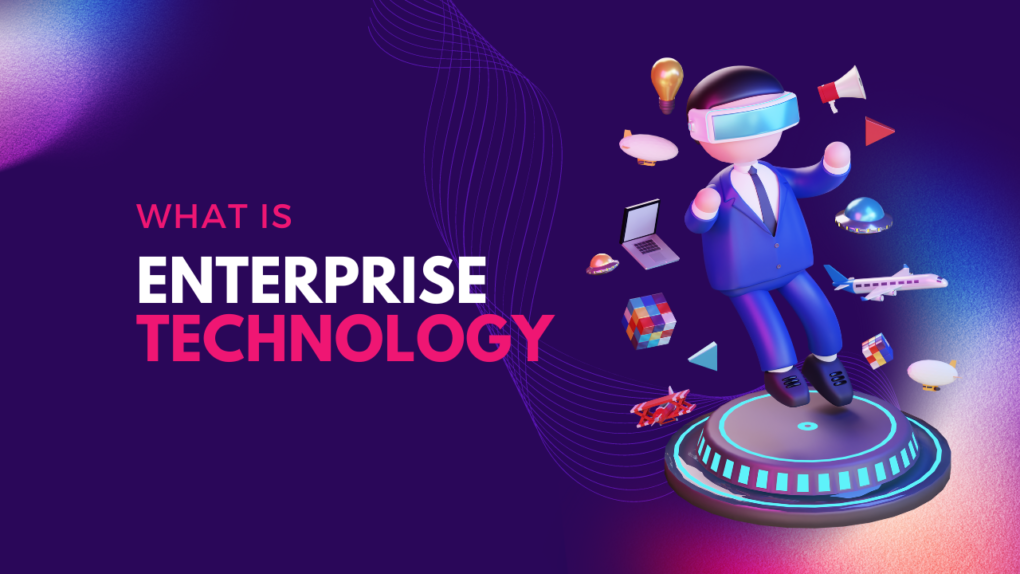In today’s digital age, businesses of all sizes are relying heavily on technology to drive their operations, streamline processes, and achieve growth. One term that has gained significant prominence is “enterprise technology.” In this article, we will delve into the concept of enterprise technology, its importance for businesses, and how it empowers organizations to thrive in a competitive landscape.
Introduction: Understanding Enterprise Technology
Enterprise technology refers to the suite of hardware, software, and systems that enable businesses to manage their operations effectively and drive growth. It encompasses a wide range of technologies tailored specifically to the needs of organizations, such as data storage and management systems, communication tools, collaboration platforms, and security solutions.
The Role of Enterprise Technology in Business Success
In the modern business landscape, technology plays a vital role in determining the success of organizations. Enterprise technology serves as the backbone of operations, supporting core functions like customer relationship management, supply chain management, financial systems, and more. It provides the infrastructure and tools necessary to optimize processes, improve decision-making, and stay ahead of the competition.
Key Components of Enterprise Technology
To understand the full scope of enterprise technology, let’s explore its key components:
Hardware Infrastructure
A robust hardware infrastructure forms the foundation of enterprise technology. This includes servers, data centers, networking equipment, computers, and other devices necessary for storing, processing, and accessing data.
Software Solutions
Enterprise software solutions are designed to meet the unique needs of businesses. These include enterprise resource planning (ERP) systems, customer relationship management (CRM) software, project management tools, and other specialized applications that automate processes and facilitate efficient operations.
Data Management Systems
Data is the lifeblood of modern businesses, and effective management is crucial. Enterprise data management systems encompass databases, data warehouses, and data analytics tools that enable businesses to collect, store, organize, and analyze vast amounts of data to gain valuable insights and make informed decisions.
Networking and Connectivity
In today’s interconnected world, seamless networking and connectivity are essential. Enterprise technology includes networking infrastructure, such as routers, switches, firewalls, and virtual private networks (VPNs), enabling secure and efficient communication within and outside the organization.
Security Measures
Protecting sensitive business information is of utmost importance. Enterprise technology incorporates robust security measures, including firewalls, encryption protocols, access controls, and intrusion detection systems, to safeguard data from unauthorized access and cyber threats.
Benefits of Implementing Enterprise Technology
The adoption of enterprise technology brings numerous benefits to businesses, regardless of their size or industry. Let’s explore some of the key advantages:
Enhanced Efficiency and Productivity
By automating routine tasks and optimizing processes, enterprise technology helps businesses streamline operations, reduce manual effort, and increase overall efficiency. This allows employees to focus on higher-value activities, leading to improved productivity and output.
Improved Decision-Making
Access to real-time data and advanced analytics empowers organizations to make data-driven decisions. Enterprise technology provides accurate insights, predictive models, and reporting capabilities, enabling business leaders to assess performance, identify trends, and make informed strategic choices.
Streamlined Communication and Collaboration
Effective communication and collaboration are vital for team success. Enterprise technology tools, such as instant messaging platforms, video conferencing solutions, and project management software, facilitate seamless collaboration among team members, regardless of their physical locations.
Scalability and Flexibility
As businesses grow, their technology needs evolve. Enterprise technology offers scalability and flexibility, allowing organizations to adapt their infrastructure and systems to accommodate changing demands. This scalability ensures that businesses can meet customer expectations and seize new opportunities without constraints.
Competitive Advantage
In a highly competitive market, staying ahead requires leveraging cutting-edge technology. Implementing enterprise technology equips businesses with the tools and capabilities to innovate, differentiate themselves, and gain a competitive edge over rivals. It enables them to deliver superior products and services while optimizing internal processes for maximum efficiency.
Challenges in Adopting Enterprise Technology
While the benefits of enterprise technology are significant, businesses often face challenges during the adoption process. It’s important to address these challenges proactively to ensure successful implementation. Here are some common hurdles:
Integration Complexity
Integrating new technology with existing systems and infrastructure can be complex. Ensuring compatibility, data migration, and seamless communication between different components requires careful planning and expertise.
Data Security and Privacy Concerns
With the increasing risk of cyber threats and data breaches, maintaining robust security measures is paramount. Protecting sensitive business information and customer data requires implementing strong security protocols and adhering to industry best practices.
Cost Considerations
Enterprise technology investments can be substantial, especially for small and medium-sized businesses. Balancing the cost of technology implementation with the expected return on investment requires careful budgeting and evaluation of long-term benefits.
Employee Training and Change Management
Adopting new technology often necessitates changes in workflows and processes. Employee training and change management efforts are crucial to ensure a smooth transition and enable employees to embrace and effectively utilize the new technology.
Best Practices for Successful Implementation
To maximize the benefits of enterprise technology implementation, organizations should follow these best practices:
Conduct a Comprehensive Needs Analysis
Before investing in any technology, thoroughly assess the specific needs and requirements of your organization. Identify pain points, areas for improvement, and strategic objectives. This analysis will guide your decision-making process and help you select the most suitable technology solutions.
Choose the Right Technology Partners
Collaborating with reliable technology partners is essential for successful implementation. Choose vendors and providers with a proven track record, expertise in your industry, and a comprehensive support system. Partnering with the right professionals ensures smooth implementation, training, and ongoing support.
Develop a Robust Implementation Plan
Create a detailed implementation plan that outlines key milestones, timelines, and responsibilities. Break the implementation process into manageable phases to minimize disruption and ensure a smooth transition. Regularly review and adjust the plan as needed to address emerging challenges and optimize outcomes.
Prioritize Data Security and Privacy
Safeguarding sensitive data should be a top priority. Implement strong security measures, educate employees on cybersecurity best practices, and ensure compliance with data protection regulations. Regularly update security protocols and perform risk assessments to stay ahead of potential threats.
Provide Ongoing Training and Support
Invest in comprehensive training programs to ensure employees are proficient in using the new technology. Ongoing support and access to technical assistance are vital to address any issues or questions that may arise. Continuous training and support foster employee confidence and maximize the benefits of the implemented enterprise technology.
Future Trends in Enterprise Technology
The world of enterprise technology continues to evolve at a rapid pace. Here are some emerging trends that are shaping the future:
Artificial Intelligence and Machine Learning
AI and machine learning technologies are revolutionizing how businesses operate. They enable automation, predictive analytics, and intelligent decision-making, unlocking new possibilities for efficiency and innovation.
Internet of Things (IoT)
The IoT connects devices and sensors, allowing businesses to gather and analyze real-time data from various sources. IoT technology enhances operational efficiency, enables predictive maintenance, and creates new opportunities for personalized customer experiences.
Cloud Computing
Cloud computing offers flexible, scalable, and cost-effective solutions for data storage, software deployment, and collaboration. It allows businesses to access their applications and data from anywhere, streamlining operations and reducing infrastructure costs.
Big Data Analytics
As data volumes continue to grow, businesses are leveraging big data analytics to extract valuable insights. Advanced analytics tools and algorithms help organizations uncover patterns, trends, and correlations that drive informed decision-making and strategic planning.
Automation and Robotics
Automation and robotics technologies are transforming industries by streamlining repetitive tasks and increasing operational efficiency. Robotic process automation (RPA) and intelligent automation are revolutionizing workflows, reducing errors, and freeing up human resources for more complex tasks.
Conclusion
Enterprise technology is an indispensable asset for businesses aiming to thrive in the digital era. It empowers organizations by providing the infrastructure, software solutions, and security measures needed to optimize operations, enhance productivity, and gain a competitive edge. While challenges may arise during the implementation process, adopting best practices and staying informed about emerging trends can help businesses unlock the full potential of enterprise technology and secure a prosperous future.




